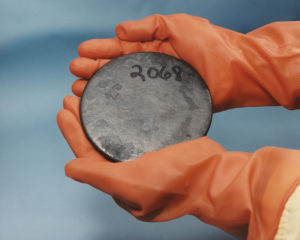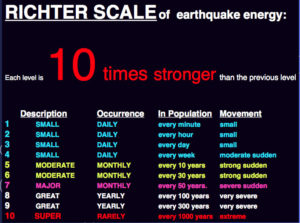Learning Outcomes
- Solve applications of logarithmic functions that involve evaluating at given inputs.
In previous sections, we learned the properties and rules for both exponential and logarithmic functions. We have seen that any exponential function can be written as a logarithmic function and vice versa. We have used exponents to solve logarithmic equations and logarithms to solve exponential equations. We are now ready to combine our skills to solve equations that model real-world situations, whether the unknown is in an exponent or in the argument of a logarithm.

One such application is called half-life, which refers to the amount of time it takes for half a given quantity of radioactive material to decay. The table below lists the half-life for several of the more common radioactive substances.
| Substance | Use | Half-life |
|---|---|---|
| gallium-[latex]67[/latex] | nuclear medicine | [latex]80[/latex] hours |
| cobalt-[latex]60[/latex] | manufacturing | [latex]5.3[/latex] years |
| technetium-[latex]99[/latex]m | nuclear medicine | [latex]6[/latex] hours |
| americium-[latex]241[/latex] | construction | [latex]432[/latex] years |
| carbon-[latex]14[/latex] | archeological dating | [latex]5,715[/latex] years |
| uranium-[latex]235[/latex] | atomic power | [latex]703,800,000[/latex] years |
We can see how widely the half-lives for these substances vary. Knowing the half-life of a substance allows us to calculate the amount remaining after a specified time. We can also solve for the amount of time it takes for some percentage of the initial amount to be left. That formula is given here:
[latex]T(n)=-\dfrac{H\log(n)}{\log(2)}[/latex]
where
- [latex]n[/latex] is the fraction of the initial amount remaining, written as a decimal
- [latex]T(n)[/latex] is the amount of time it takes to reach that amount remaining
- [latex]H[/latex] is the half-life of the substance
Example
How long will it take for ten percent of a [latex]1000[/latex]-gram sample of uranium-[latex]235[/latex] to decay?
The pH Scale
In chemistry, pH is used as a measure of the acidity or alkalinity of a substance. The pH scale runs from [latex]0[/latex] to [latex]14[/latex]. Substances with a pH less than [latex]7[/latex] are considered acidic, and substances with a pH greater than [latex]7[/latex] are said to be alkaline (or basic), with [latex]7[/latex] being neutral. In our next example, we will find how doubling the concentration of hydrogen ions in a liquid affects pH.
Example
 In chemistry, [latex]\text{pH}=-\log\left[{H}^{+}\right],[/latex] where [latex]\left[{H}^{+}\right][/latex] is the concentration of hydrogen ions in a liquid measured in moles per liter. What is the pH of a bottle of lemon juice with hydrogen ion concentration of 0.0054 moles per liter? Round to two decimal places.
In chemistry, [latex]\text{pH}=-\log\left[{H}^{+}\right],[/latex] where [latex]\left[{H}^{+}\right][/latex] is the concentration of hydrogen ions in a liquid measured in moles per liter. What is the pH of a bottle of lemon juice with hydrogen ion concentration of 0.0054 moles per liter? Round to two decimal places.
Richter Scale

The Richter Scale of earthquake energy.
The Richter scale is a logarithmic function that is used to measure the magnitude of earthquakes. The magnitude of an earthquake is related to how much energy is released by the quake. Instruments called seismographs detect movement in the earth. The smallest movement that can be detected shows on a seismograph as a wave with width [latex]A_{0}[/latex]. This may occur just from someone jumping up and down in the same room as the instrument. A large earthquake will produce a bigger movement on the seismograph.
The formula for the magnitude of an earthquake is as follows:
[latex]R=\log\left(\frac{A}{A_{0}}\right)[/latex]
where
- [latex]R[/latex] is the magnitude of the earthquake
- [latex]A[/latex] is the width of the wave in the seismograph produced by the earthquake
- [latex]A_0[/latex] is the width of the wave in the seismograph produced by the smallest measurable disturbance.
The intensity of an earthquake will typically measure between [latex]2[/latex] and [latex]10[/latex] on the Richter scale. Any earthquakes registering below a [latex]5[/latex] are fairly minor; they may shake the ground a bit but are seldom strong enough to cause much damage. Earthquakes with a Richter rating between [latex]5[/latex] and [latex]7.9[/latex] are much more severe, and any quake above an [latex]8[/latex] is likely to cause massive damage. (The highest rating ever recorded for an earthquake is [latex]9.5[/latex] during the [latex]1960[/latex] Valdivia earthquake in Chile.)
Example
An earthquake is measured with a wave width [latex]392[/latex] times as great as [latex]A_{0}[/latex]. What is the magnitude of this earthquake, to the nearest tenth, using the Richter scale?
A difference of [latex]1[/latex] point on the Richter scale equates to a [latex]10[/latex]-fold difference in the amplitude of the earthquake (which is related to the wave strength). This means that an earthquake that measures [latex]3.6[/latex] on the Richter scale has [latex]10[/latex] times the amplitude of one that measures [latex]2.6[/latex]. The Valdivia earthquake with a magnitude of 9.5 had an amplitude about ten million times greater than the [latex]2.6[/latex] earthquake!
In the following video, we show another example of how to calculate the magnitude of an earthquake.
Summary
Logarithmic functions appear in many natural settings in scientific applications. Some of these naturally arise when solving for time in an application with exponential growth or decay. Others occur when a model uses data that is recorded on a logarithmic scale.
Candela Citations
- Precalculus. Authored by: Jay Abramson, et al.. Provided by: OpenStax. Located at: http://cnx.org/contents/fd53eae1-fa23-47c7-bb1b-972349835c3c@5.175. License: CC BY: Attribution. License Terms: Download For Free at : http://cnx.org/contents/fd53eae1-fa23-47c7-bb1b-972349835c3c@5.175.
- Lemon. Authored by: Andru00e9 Karwath. Located at: https://commons.wikimedia.org/w/index.php?curid=59992. License: CC BY-SA: Attribution-ShareAlike
- HEUraniumC. Authored by: http://web.archive.org/web/20050829231403/. Located at: http://web.em.doe.gov/takstock/phochp3a.html,. License: Public Domain: No Known Copyright
- Earthquake_Richter_Scale. Authored by: Webber. Located at: https://commons.wikimedia.org/w/index.php?curid=1567023. License: Public Domain: No Known Copyright
